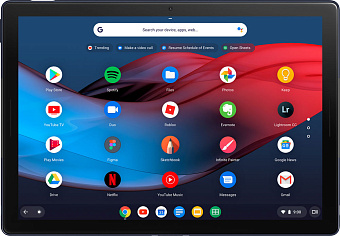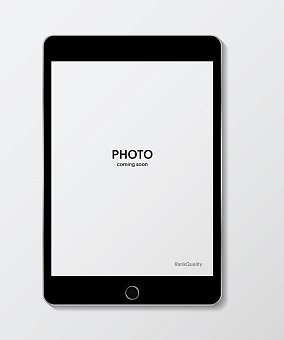 Google Pixel Slate
Google Pixel Slate
 Microsoft Surface Pro 6
Microsoft Surface Pro 6
Comparision Google Pixel Slate vs Microsoft Surface Pro 6
Grade
Top specs and features
Main camera resolution
Pixel Density
Display size
Front camera resolution
RAM
Description
Welcome to our in-depth comparison of two tablet competitors: Google Pixel Slate and Microsoft Surface Pro 6. Both tablets have been designed with you in mind and each has its own strengths. Let's dive into the details together.
The width of Google Pixel Slate is 290.85 mm and Microsoft Surface Pro 6 is 292 mm. The height of the first tablet is 202.04 mm and the second one is 201 mm. Thickness Google Pixel Slate - 7 mm, against - 8.4 mm. Google Pixel Slate weighs 731g vs. 770g.
Google Pixel Slate runs on Android There is no data. The security class is There is no data. Microsoft Surface Pro 6 works on Android There is no data. Has the protection class There is no data.
Screen
Google Pixel Slate has a 12.3 inch screen. The display is based on the There is no data matrix. The screen resolution is 3000 x 2000 px and the pixel density reaches 293 ppi, providing rich and vivid images. In comparison, Microsoft Surface Pro 6 offers a 12.3 inch display. Matrix LCD IPS. Resolution 2736 x 1824 px and density 267ppi ensure excellent detail and clarity.
Performance
The heart of Google Pixel Slate is a processor There is no data operating at a frequency of There is no data MHz. Processor configuration There is no data. Google Pixel Slate is equipped with There is no data cores. Ships with 16 GB of RAM. The video processor There is no data is responsible for the graphics. The maximum frequency of the graphics core 300 MHz. All this ensures smooth and fast operation of applications and games. In contrast, Microsoft Surface Pro 6 runs on a Intel Core i7 8750U processor running at 4 MHz. Processor configuration There is no data. The amount of RAM is 16 GB of RAM. Microsoft Surface Pro 6 has a video processor Intel UHD Graphics 620. The GPU clock reaches 300 MHz, offering superior performance and fast application performance.
According to AnTuTu Benchmark, Google Pixel Slate scores There is no data points, while Microsoft Surface Pro 6 scores There is no data points.
Camera and Video
Google Pixel Slate's main camera resolution is 8 MP. Aperture f/1.8. The There is no data sensor delivers great pictures and videos. It also features a 8MP front-facing camera. Front camera aperture f/1.9. Microsoft Surface Pro 6 has a 8 MP camera in its arsenal. Its aperture is f/There is no data. The manufacturer did not forget about the front camera and provided it with 5 MP resolution. Front camera aperture at Microsoft Surface Pro 6 f/1.9.
Battery and Charging
Google Pixel Slate has There is no data battery. Its capacity is There is no data mAh. Supports fast charging with a power of There is no data W. In contrast, Microsoft Surface Pro 6 offers battery with a capacity of 5087 mAh. Supports fast charging with There is no data W power, which provides fast & nbsp; charging time.
Memory and storageGoogle Pixel Slate has built-in memory 256 GB for storing files and data. On the other hand, Microsoft Surface Pro 6 offers 512 GB of internal memory.
Why Microsoft Surface Pro 6 is better than Google Pixel Slate
- Pixel Density 293 ppi против 267 ppi, more on 10%
- Front camera resolution 8 MP против 5 MP, more on 60%
- Thickness 7 mm против 8.4 mm, less by -17%
- Weight 731 g против 770 g, less by -5%
Google Pixel Slate vs Microsoft Surface Pro 6: highlights


Performance
Camera
Battery
Other
Main characteristics
Display
Interfaces and communications
FAQ
How do the benchmark results differ between Google Pixel Slate and Microsoft Surface Pro 6?
According to the AnTuTu benchmark, Google Pixel Slate scored There is no data points, while Microsoft Surface Pro 6 scored There is no data out of a possible 911349 points.
Which tablet has better camera - Google Pixel Slate or Microsoft Surface Pro 6?
The main camera of Google Pixel Slate has a sensor resolution of 8 megapixels, while Microsoft Surface Pro 6 has a sensor resolution of 8 megapixels.
Which battery is better - Google Pixel Slate or Microsoft Surface Pro 6?
Google Pixel Slate's battery capacity is There is no data mAh, while Microsoft Surface Pro 6's is 5087 mAh.
What memory is available on these tablets?
Google Pixel Slate has a built-in memory of 256 GB and Microsoft Surface Pro 6 has 512 GB.
What screens are used in these tablets?
The screen of Google Pixel Slate has a There is no data matrix. Microsoft Surface Pro 6 uses the LCD IPS matrix.
What processor is offered in Google Pixel Slate and Microsoft Surface Pro 6?
Google Pixel Slate is running on processor There is no data and Microsoft Surface Pro 6 is running on processor Intel Core i7 8750U.
What is the screen resolution of Google Pixel Slate and Microsoft Surface Pro 6 tablets?
Google Pixel Slate has a display resolution of 3000 x 2000 inches and Microsoft Surface Pro 6 has a resolution of 2736 x 1824 inches.
What is the weight of Google Pixel Slate and Microsoft Surface Pro 6 tablets?
Google Pixel Slate weighs 731 grams while Microsoft Surface Pro 6 weighs 770 grams.
How many SIM cards do these tablets support?
Google Pixel Slate supports up to There is no data SIM cards. Microsoft Surface Pro 6 this number is There is no data.
What moisture protection do these tablets have?
Google Pixel Slate is IPThere is no data waterproof. Microsoft Surface Pro 6 this value is IPThere is no data.
How much RAM is installed in Google Pixel Slate and Microsoft Surface Pro 6?
The maximum amount of RAM in Google Pixel Slate is 16 GB, and in Microsoft Surface Pro 6 it is 16 GB.





















